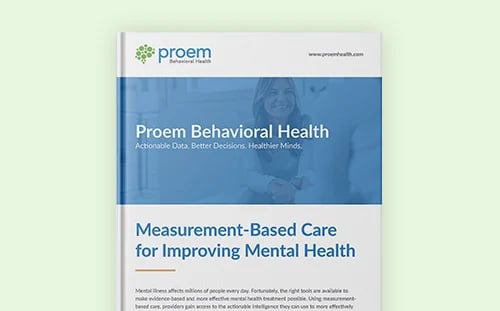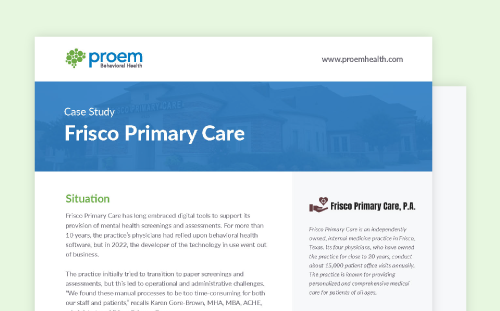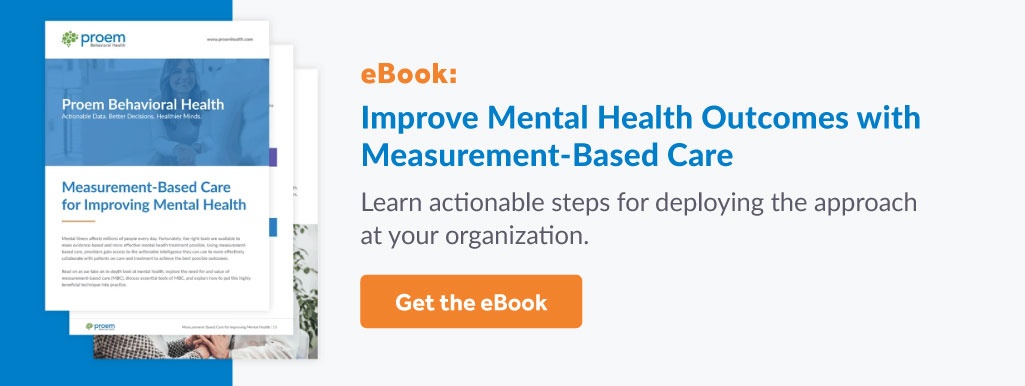Mental health assessment tools, including mental health scales, are widely used in behavioral health and have been for years. They have become essential when screening for mental health conditions, making a formal diagnosis of a mental health condition, assessing symptom severity, and/or monitoring outcomes across the course of therapy. These same mental health scales can also be used by physical health care providers such as primary care physicians, pediatricians, and OB-GYN providers to help establish a baseline of mental health for their patients and triage patients needing help.
Technology enables all health care providers to better use mental health assessment tools, offering an easier way to effectively collect and analyze patient health data at scale to help improve patient care and identify evidence-based clinical best practices.
Why Use Scales for Measuring Mental Health?
In many areas of general medical practice, quantitative measurements are routinely used to assess patient health status — for instance, taking a patient’s temperature or recording blood pressure.
The situation in mental health is different and significantly more complex. Mental health status can relate to a wide range of patient experiences, feelings, actions and behaviors –– areas that aren’t always easily observable. Gaining this information through lengthy interviewing can be helpful, but it’s not practical with large numbers of patients to see, nor is the interviewing process consistent across care settings and over time.
For this reason, scales have long been used to provide a measurable –– and comparable –– means to capture health information, help assess and diagnose mental health conditions, and monitor patient progress. There are some misconceptions about use of mental health scales. As an example, many generally assume that measurement scales are used only with adults. Yet, there are many scales specifically designed for use with children, such as the Mini International Neuropsychiatric Interview Kid Interview (M.I.N.I. Kid), a mental health scale questionnaire for children and adolescents (ages 6-17) used to assesses common disorders in pediatric mental health.
If you’re wondering, “Is there a scale for mental health and wellness?” The answer is yes! Rating scales aren’t always focused on identifying and managing a disorder. The positive mental health scale (Lukat et al.'s PMH-scale) identifies factors associated with positive mental health and wellbeing, such as presence of stable relationships, sense of purpose and direction, and self-acceptance.
What Assessment Tools Are Used in Mental Health?
There is a myriad of psychological assessment tools. Here are some of the most common scales for measuring mental health and their area of application:
- Cognitive Therapy Rating Scale (CTRS) – cognitive therapy competence
- Drinking Motives Questionnaire – addiction
- Generalized Anxiety Disorder 7-Item (GAD7) – anxiety
- Clinician-Rated Severity of Autism Spectrum and Social Communication Disorders – autism
- BDD Modification of the YBOCS (BDD-YBOCS) – body dysmorphic disorder
- Brown Assessment of Beliefs Scale (BABS) – body dysmorphic disorder
- Mood Disorder Questionnaire (MDQ) – bipolar
- Patient Health Questionnaire 9 (PHQ9) – depression
- Yale Brown Obsessive Compulsive Scale (YBOCS) – obsessive compulsive disorder
- Sheehan-Suicidality Tracking Scale (S-STS) – suicide
There are many mental health rating scales, and the number continues to grow as researchers capture and analyze more data. To help you identify the right scales for your organization, learn eight things to look for in mental health assessment solutions.
How Are Mental Health Scales Used?
To illustrate how a combination of behavioral health questionnaires and scales may be used at different points of care, consider applications related to body dysmorphic disorder (BDD). BDD is a serious mental illness related to obsessive-compulsive disorder. It involves a fixation on one or more physical characteristics. The most common characteristics, according to Mayo Clinic, include:
- Face (e.g., nose, complexion, wrinkles, acne)
- Hair (e.g., appearance, thinning and baldness)
- Skin and vein appearance
- Breast size
- Muscle size and tone
- Genitalia
A person with BDD, according to Cleveland Clinic, “is consumed with thoughts about an imagined or very slight defect in their body.” This obsession interferes with the person’s ability to work, attend school or function in home and social settings. A mix of questionnaires and scales are often used by clinicians for screening, assessment and monitoring progress with patients. Let's take a closer look at these applications.
Screening: The BDDQ (Body Dysmorphic Disorder Questionnaire) is available for use by clinicians and researchers. The questionnaire, which takes 1 to 5 minutes to administer, helps identify which patients should undergo further diagnosis with the BDD Diagnostic Module. Adolescent and adult versions of the BDDQ are available.
As a questionnaire, compared to a rating scale, responses have no comparative element. Responses are either yes or no. As an example, one question asks: “Is your main concern with how you look that you aren’t thin enough or that you might get too fat?” Yes / No
Assessment: Assessment goes into more detail to give providers an indication of the severity or frequency of symptoms. The BDD Module (Body Dysmorphic Disorder Diagnostic Module), which is based on the DSM-5 diagnostic criteria for BDD, evaluates appearance preoccupations and repetitive behaviors of clinical significance, aids differentiation from an eating disorder, and uses specifiers to identify patients with either muscle dysmorphia or insight specifiers.
An example of a question from this scale is the following: “Are you preoccupied with the idea that your body build is too small or that you’re not muscular enough?” Based on the response, the clinician rates on a 3-point scale as:
- 1 = absent
- 2 = sub-threshold
- 3 = threshold or true
Monitoring: Another type of scale can be used to identify changes in patient health with treatment. The Yale-Brown Obsessive-Compulsive Scale modified for Body Dysmorphic Disorder (BDD-YBOCS) is an example of a scale commonly used for monitoring progress of patients diagnosed with BDD. It features a series of 12 semi-structured items to assess the severity of BDD during the previous week, asking patients to respond to and rate items such as “I check my appearance (e.g., in mirrors, by touching with my fingers, by taking photos of myself)” or “I avoid situations or people because of my appearance.”
For each of these items, patients are asked to rate the level to which they exhibit each behavior on a scale of 0-4 from “not at all” to “all the time.”
Comparing data from week to week and over time helps clinicians identify whether a patient’s health is maintaining, improving or worsening. Tracking health this way — especially when viewed across patient populations — helps clinicians and researchers identify which interventions support best outcomes and develop evidence-based best practices.
Expanding Use of Mental Health Assessment Tools With Proem
Mental health assessment tools can provide a multi-dimensional approach to help providers assess, diagnose and monitor patients by establishing a baseline, measuring change through treatment and intervention, and measuring outcomes longitudinally across time. This level of data will be critical for health care professionals who engage in risk-based or value-based payment models and/or measurement-based care practices.
Interested in more information about incorporating mental health scales and tools into your practice? Contact Proem to learn about your options.





.png)








